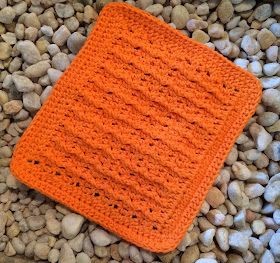CrochetMenScarvesHatsGlovesSweatersCardigansSocksOther clothingWomenScarvesHatsGlovesShawls and cover upSweatersCardigansSocksSlippersBagsOther clothingChildrenScarvesHatsGlovesSweatersCardigansSocksSlippersOther clothingHomeBlankets and plaidsRugsHome decorationsPetsSchemesKnittingOther hand-madeChat
Crochet Ripple Ridges Dishcloth

The Crochet Ripple Ridges Dishcloth is a charming and practical addition to any kitchen! This delightful pattern combines soothing ripple stitches with textured ridges, creating a unique and eye-catching design. Perfect for adding a touch of handmade charm to your daily dishwashing routine, this dishcloth is not only functional but also a joy to crochet.
Whether you're a seasoned crocheter or just starting out, this project is a fun and rewarding way to showcase your creative skills while creating something useful for your home. So grab your yarn and hook, and let's crochet some ripple ridges that will make washing dishes a little more enjoyable!Yarn: Peaches and Cream worsted cotton, 2 oz. ball
Hook: G6/4mm
Gauge: 16 sts, 8 rows = 4”
Finished size: 9 ½” across, 8” tall
Special stitches:
bpdc- back post double crochet. A stitch made around the back of the post of the dc instead of into the “v” on top of the dc. Yo, insert hook from back to front, then back again around the post of the dc indicated, draw up a loop, yo pull through 2 loops on hook, yo pull through last 2 loops on hook. Bpdc made.
Fpdc- front post double crochet. A stitch made around the front of the post of the dc instead of into the “v” on top of the dc. Yo, insert hook through the front to the back, then in front again around the post of the dc indicated, draw up a loop, yo pull through 2 loops on hook, yo pull through last 2 loops on hook. Fpdc made.
Notes for post stitches: After completing a post st, the “v” of the st in the row below will remain empty, as you made a dc in front of, or behind it instead of on top of it. Be sure not to mistakenly st in that “v” when making your next regular dc. If you do, your ridges will not be parallel!
FInishing notes:
“hdc evenly along edge” means make approximately 2 sts into the side of every dc along the edge until you reach the corner. There are many tutorials online which further explain the specific techniques and rules of thumb for edge stitching.
“Invisible join” is a technique of joining rounds by sewing a faux stitch into a project’s final stitches with a yarn needle in order to avoid the noticeable knot made when finishing with a slip-stitch. There are many helpful tutorials online to assist with this finishing technique, if desired.
Dishcloth:
Chain 30.
Row 1: hdc into each chain across. Ch 1, turn. (29 hdc)
Row 2: dc into each st across. Ch 2, turn. (29 dc)
Row 3: dc in each of the first 2 sts, *bpdc in the next st, dc in each of the next 2 sts*, *repeat across. Ch 2, turn.
Row 4: dc in each of the first 2 sts, *fpdc in the next st, dc in each of the next 2 sts*, *repeat across. Ch 2, turn.
Rows 5-13: repeat rows 3 and 4 five more times. On row 13 at end, ch 1. Do not break yarn.
Finishing:
Round 1: hdc into each st across, make 3 hdc into the last st to form corner. Pivot work, hdc evenly along edge of cloth, make 3 hdc into bottom corner. Slst into each hdc along the bottom edge, make 3 hdc into corner. Hdc evenly along edge of cloth, make 3 hdc into top corner, join with a slst to first hdc of rnd, ch 1, do not turn.
Round 2: *hdc into each st across to corner, at corner, make 3 hdc into the center st of the 3 hdc group of the previous rnd*, *repeat for each edge around. Join with a slst or an invisible join to first hdc of rnd. Fo, securely weave in ends.
No comments
Write a comment
